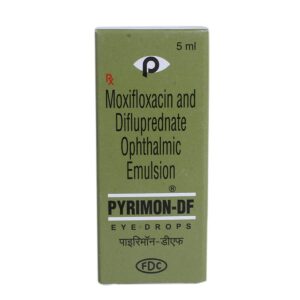MOXIFLOXACIN + DIFLUPREDNATE
Moxifloxacin: Moxifloxacin is an antibiotic drug that belongs to the fluoroquinolone class. It is used to treat a variety of bacterial infections, including respiratory tract infections, skin and soft tissue infections, and urinary tract infections.
The mechanism of action of Moxifloxacin involves inhibiting the activity of bacterial DNA gyrase and topoisomerase IV enzymes, which are essential for the replication, transcription, and repair of DNA in bacteria. By inhibiting these enzymes, Moxifloxacin prevents bacteria from growing and multiplying, ultimately leading to their destruction.
The dose of Moxifloxacin may vary depending on the severity and type of infection. For most infections, the recommended oral dose is 400 mg once daily, taken with or without food. In certain cases, such as pneumonia, intravenous administration may be necessary.
Although Moxifloxacin is generally well-tolerated, it can cause several side effects. Common side effects may include nausea, vomiting, diarrhea, headache, dizziness, and rash. It may also cause more serious adverse effects, such as tendon rupture, especially in older patients. Additionally, Moxifloxacin has been associated with prolongation of QT interval, which could lead to an irregular heartbeat.
It is important to note that Moxifloxacin should be used with caution in patients with a history of heart disease, electrolyte abnormalities, or those taking medications that can prolong QT interval. It is also contraindicated in patients with a history of hypersensitivity to fluoroquinolones.
As with any medication, it is essential to consult a healthcare professional for proper diagnosis, dosage, and to discuss potential side effects or drug interactions before starting Moxifloxacin.
Difluprednate: Difluprednate is a corticosteroid drug that is used to treat inflammation of the eye. It is available as eye drops and is typically prescribed for conditions such as uveitis, eye allergies, and postoperative inflammation.
The mechanism of action of difluprednate involves the inhibition of various inflammatory mediators and enzymes, leading to a reduction in inflammation. It works by binding to glucocorticoid receptors and modulating gene expression, ultimately suppressing the immune response and reducing swelling, redness, and pain in the eye.
The usual dosage of difluprednate depends on the specific condition being treated. However, a common starting dose is one drop of 0.05% difluprednate eye drops applied to the affected eye(s) four times a day. The dosage may be adjusted based on the individual’s response and the severity of the condition.
Like any medication, difluprednate may cause side effects. Common side effects include temporary stinging or burning sensation upon application, temporary blurred vision, taste changes, headache, and eye discomfort. It may also increase the risk of infection, delay wound healing, or increase intraocular pressure. If any severe side effects occur, such as eye pain or vision changes, it is important to contact a healthcare professional immediately.
It is important to note that difluprednate is a prescription medication and should only be used under the guidance of a healthcare provider.

